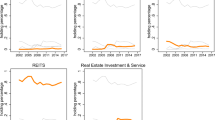Summary
Using a Switzerland-specific Carhart model, we study the risk-adjusted performance of actively and passively managed mutual funds investing in Swiss stocks from 1989 to 2007. We also compare the performance of actively managed funds to passively managed funds instead of comparing them to a theoretical index. For a sample of 160 funds with 13,672 monthly observations we find that active as well as passive funds significantly underperform indices on an aggregated basis. However, active large-cap funds significantly underperform and active Small&Mid-Cap-funds significantly outperform the index. Further, we find that the average manager of an active Swiss equity fund systematically overweights small-cap, value, and low-momentum stocks. When directly comparing active to passive funds, active funds significantly underperform by −1.1% p.a. on average. While active institutional funds can almost keep up with the performance of passive funds, active retail funds cannot and drive the substantial underperformance observed for active funds. Finally, active funds perform better before the millennium than thereafter. This robust result supports the hypothesis of ongoing efficiency increases in the Swiss stock market.
Article PDF
Similar content being viewed by others
References
Ammann, Manuel, Corinne Häller and Rico von Wyss (2002), „Performance Schweizerischer Anlagestiftungen“, Financial Markets and Portfolio Management, 16, pp. 446–466.
Ammann, Manuel and Michael Steiner (2008), “Risk Factors for the Swiss Stock Market”, Swiss Journal of Economics and Statistics, 144, pp. 1–35.
Avramov, Doron and Russ Wermers (2006), “Investing in Mutual Funds when Returns are Predictable”, Journal of Financial Economics, 81, pp. 339–377.
Bams, Dennis and Roger Otten (2002), “European Mutual Fund Performance”, European Financial Management, 8, pp. 75–101.
Berk, Jonathan B. (2005), “Five Myths of Active Portfolio Management”, The Journal of Portfolio Mangement, 31, pp. 27–31.
Bogle, John C. (1998), “The Implications of Style Analysis for Mutual Fund Performance Evaluation”, The Journal of Portfolio Management, 24, pp. 34–42.
Bogle, John C. (2002), “An Index Fund Fundamentalist”, The Journal of Portfolio Management, 28, pp. 31–38.
Bogle, John C. (2005), “The Mutual Fund Industry 60 Years Later: For Better or Worse?”, Financial Analysts Journal, 61, pp. 15–24.
Brown, Stephen J. and William N. Goetzmann (1995), “Performance Persistence”, The Journal of Finance, 50, pp. 679–698.
Carhart, Mark M. (1997), “On Persistence in Mutual Fund Performance”, The Journal of Finance, 52, pp. 57–82.
Carhart, Mark M., Jennifer N. Carpenter, Anthony W. Lynch and David K. Musto (2002), “Mutual Fund Survivorship”, The Review of Financial Studies, 15, pp. 1439–1463.
Costa, Bruce A., Keith Jakob and Gary E. Porter (2006), “Mutual Fund Performance and Changing Market Trends 1990–2001: Does Manager Experience Matter?”, The Journal of Investing, 15, pp. 79–86.
Deaves, Richard (2004), “Data-Conditioning Biases, Performance, Persistence and Flows: The Case of Canadian Equity Funds”, Journal of Banking and Finance, 28, pp. 673–694.
Elton, Edwin J., Martin J. Gruber and Christopher R. Blake (1996), “Survivorship Bias and Mutual Fund Performance”, The Review of Financial Studies, 9, pp. 1097–1120.
Fama, Eugene F. and Kenneth R. French (1993), “Common Risk Factors in the Returns on Stocks and Bonds”, Journal of Financial Economics, 33, pp. 3–56.
Fortin, Rich and Stuart Michelson (2002), “Indexing Versus Active Mutual Fund Management”, Journal of Financial Planning, 15, pp. 82–94.
Griese, Knut and Alexander Kempf (2003), „Lohnt aktives Fondsmanagement aus Anlegersicht?“, Zeitschrift für Betriebswirtschaft, 73, pp. 201–224.
Grinblatt, Mark and Sheridan Titman (1989), “Mutual Fund Performance: An Analysis of Quarterly Portfolio Holdings”, The Journal of Business, 62, pp. 393–416.
Gruber, Martin J. (1996), “Another Puzzle: The Growth in Actively Managed Mutual Funds”, The Journal of Finance, 51, pp. 783–810.
Jensen, Michael (1968), “The Performance of Mutual Funds in the Period 1945–1964”, The Journal of Finance, 23, pp. 389–416.
Kizer, Jared (2005), “Index Fundamentalism Revisited — Redux”, The Journal of Portfolio Management, 31, pp. 112–119.
Lhabitant, Francois-Serge (1995), “Mutual Funds Performance: Empirical Tests on the Swiss Market”, Financial Markets and Portfolio Management, 9, pp. 330–351.
Lhabitant, Francois-Serge (2001), “On Swiss Timing and Selectivity: In the Quest of Alpha”, Financial Markets and Portfolio Management, 15, pp. 154–172.
Lehmann, Bruce N. and David Modest (1987), “Mutual Fund Performance Evaluation: A Comparison of Benchmarks and Benchmark Comparisons”, The Journal of Finance, 42, pp. 233–265.
Malkiel, Burton G. (1995), “Returns from Investing in Equity Mutual Funds 1971 to 1991”, The Journal of Finance, 50, pp. 549–572.
Malkiel, Burton G. (2003), “Passive Investment Strategies and Efficient Markets”, European Financial Management, 9, pp. 1–10.
Malkiel, Burton G. (2005), “Reflections on the Efficient Market Hypothesis: 30 Years Later”, The Financial Review, 40, pp. 1–9.
Minor, Dylan B. (2001), “Beware of Index Fund Fundamentalists”, The Journal of Portfolio Management, 27, pp. 45–50.
Minor, Dylan B. (2003), “Transcending the Active/Passive Debate”, The Journal of Investing, 12, pp. 74–82.
Reinker, Kenneth S. and Edward Tower (2004), “Index Fundamentalism Revisited”, Journal of Portfolio Management, 30, pp. 37–50.
Von Wyss, Rico (2001), “Performance Measurement of Equity Funds — Do the SPPS Enhance Transparency?”, Financial Markets and Portfolio Management, 15, pp. 173–186.
Wermers, Russ (2000), “Mutual Fund Performance: An Empirical Decomposition into Stock-Picking Talent, Style, Transaction Costs, and Expenses”, The Journal of Finance, 55, pp. 1655–1703.
Zimmermann, Heinz and Claudia Zogg-Wetter (1992), „Performance-Messung schweizerischer Aktienfonds: Markt-Timing und Selektivität“, Swiss Journal of Economics and Statistics, 128, pp. 133–159.
Author information
Authors and Affiliations
Corresponding author
Additional information
The authors are grateful to Hanspeter Wohlwend, Vadim Safranov, Jan Martin Rous, Sven Wiedmer, Michael Frei, the participants of the “Topics in Finance” seminar at the University of St.Gallen, and the anonymous referees for their valuable comments.
Rights and permissions
Open Access This article is distributed under the terms of the Creative Commons Attribution 2.0 International License ( https://creativecommons.org/licenses/by/2.0 ), which permits unrestricted use, distribution, and reproduction in any medium, provided the original work is properly cited.
About this article
Cite this article
Ammann, M., Steiner, M. The Performance of Actively and Passively Managed Swiss Equity Funds. Swiss J Economics Statistics 145, 1–36 (2009). https://doi.org/10.1007/BF03399273
Published:
Issue Date:
DOI: https://doi.org/10.1007/BF03399273




